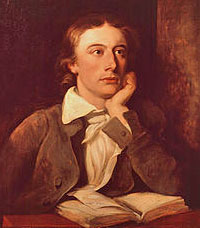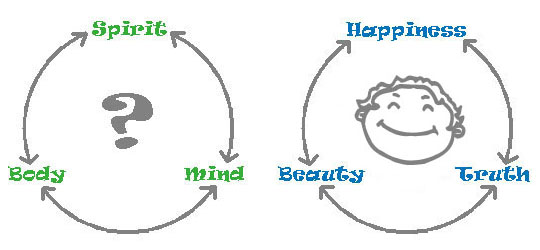14. Beauty - Truth - Happiness : a 3-dimensional perception
Previous - Next - Contents
 Below the final strophe of John Keats's poem Ode on a Grecian Urn.
Below the final strophe of John Keats's poem Ode on a Grecian Urn.
When old age shall this generation waste,
Thou shalt remain, in midst of other woe
Than ours, a friend to man, to whom thou say'st,
"Beauty is truth, truth beauty," - that is all
Ye know on earth, and all ye need to know.
|
They are the most discussed five lines of his work, from the moment the poem was
published in 1819.
"Who makes this statement, and to whom is it addressed? The urn to the reader?" "And what
does this ending mean, is it not too simplistic?" Etc.
I will leave all those critics and poets to their own debate (which appears to a
layman like me as being rather trivial), and make my own statement here : I believe
John Keats was absolutely spot on!
In his 1827 novel Armance Stendhal strongly agrees with Keates, when Madam de Bonnivet proclaims : "What is really beautiful must always be true."
During this past century artists have broken away from the traditional
figurative (or in
other ways easy to comprehend) art, to progress through a variety of impressionistic
and abstract art forms, constantly seeking new directions of expression.
As a
consequence the public's artistic perception has been challenged to grow with it, while
left with little more than a single reliable criteria for judgement : "Does this art ring true?". In other words does it
reflect a
(perhaps abstract) truth, or is it false?
And of course for any work of art (be it
painting, sculpture, music or literature) to survive the passage of time (like Keat's
Grecian urn) it must contain the essence of truth.
When we look at the flip side of John Keats' equation : "Truth (is)
Beauty", his statement is equally fundamental and definitive.
For ask any competent scientist what he looks for when he has made a new
discovery, developed a new model, theory or formula, and he will reply "If my theory has elegance, simplicity, beauty, I am very confident
I have exposed the truth!"
|
Look at Einstein's breathtaking formula e =
mc2 for example. It reveals the simple relationship that exists
between the three fundamental elements of our entire universe : energy (e), mass
(m) and the ultimate speed possible (of light, c). It represents truth and beauty of
mega proportions.
Or take Pythagoras who discovered (amongst many other things), that given a
length of string which produces (when vibrating) a certain fundamental pitch,
then 3/4 of that string length will produce a perfect 4th, 2/3 of its length a
perfect 5th and half that string length a pitch one octave higher than
the fundamental.
And what about Archimedes who found that the buoyancy force of an object
immersed in a fluid is equal to the mass (weight) of the volume of fluid it
replaces.
|
One can continue this list with countless examples, but the strong correlation between
beauty and truth is always there.
Beauty is reflected in the simple and elegant expression of Einstein's
formula, the truth is hidden in its meaning. We can therefore
confirm John Keats' statement and elaborate that beauty is the visual or metal
expression of truth.
From
Stendhal's proposition ("Beauty is the promise of Happiness."), it follows that the
truth (through its expression of beauty) can make us happy. But truth
also makes us happy directly (through its meaning, rather than its "external"
beauty) on its own accord.
Take Archimedes for example (taken from
Wikipedia).
The most widely known anecdote about Archimedes tells of how he invented a
method for determining the volume of an object with an irregular shape.
According
to Vitruvius, a votive crown for a temple had been made for King Hiero II, who had
supplied the pure gold to be used, and Archimedes was asked to determine whether some
silver had been substituted by the dishonest goldsmith.
Archimedes had to
solve the problem without damaging the crown, so he could not melt it down into a
regularly shaped body in order to calculate its density.
 While taking a bath, he noticed that the level of the water in the tub rose as he got
in, and realized that this effect could be used to determine the volume of the crown.
While taking a bath, he noticed that the level of the water in the tub rose as he got
in, and realized that this effect could be used to determine the volume of the crown.
For practical purposes water is incompressible, so the submerged crown would displace
an amount of water equal to its own volume.
By dividing the mass of the crown by
the volume of water displaced, the density of the crown could be obtained.
This density
would be lower than that of gold if cheaper and less dense metals had been added.
Archimedes then took to the streets naked, so excited by his discovery
that he had forgotten to dress, crying "Eureka!" (Greek: meaning "I have found
it!"). The test was conducted successfully, proving that silver had indeed been mixed
in.
|
At various times throughout my life I have felt exactly the same as Archimedes
(although never have taken my clothes off). After discovering the solution to a problem,
a new idea in the field of geology, or of music, or even after writing down (and at
the same time discovering) a new perspective on some of my Blog entries.
These events fill one with a great sense of satisfaction and happiness, and
are preserved (in one's memory) throughout life to resurface every time one thinks
about them.
Equally the truths (discoveries, ideas) by others fill me with satisfaction and
happiness, for I see them as great human achievements as well as objects of great
beauty.
So we have now arrived at a point where we can see happiness not as a single,
isolated entity, but as an integral member of a 3-dimensional perception (?) formed by
beauty, truth and happiness.
 Immediately as this thought springs to mind I sense a distinct echo from the
three elements that constitute a human being : body, mind and spirit.
Or does there exist a real correlation (or even a connection) between the two, where
:
Immediately as this thought springs to mind I sense a distinct echo from the
three elements that constitute a human being : body, mind and spirit.
Or does there exist a real correlation (or even a connection) between the two, where
:
- the body perceives (through seeing, hearing, touching, smelling)
beauty
- the mind appreciates the truth
- and the spirit is buoyed by happiness
|
Seen from the perspective of Darwinian Happiness as put
forward by John Grinde, Happiness (within the context I have placed it here) is
the reward for our successful quest to create Beauty and to discover
new Truths (as well as for the conscious appreciation of both). As a consequence
Happiness, in turn, becomes an incentive (adding to our inborn curiosity and need
for creative self expression) for further efforts in these two areas.
This 3-dimensional
interplay is to the benefit of us all, as it contributes (according to Grinde's findings)
to the positive genetic force, which propels us forward along our
species' path of evolution and successful propagation.
Next Page -
Top of Page
Copyright © 2011 Michael Furstner
|


 Immediately as this thought springs to mind I sense a distinct echo from the
three elements that constitute a human being : body, mind and spirit.
Or does there exist a real correlation (or even a connection) between the two, where
:
Immediately as this thought springs to mind I sense a distinct echo from the
three elements that constitute a human being : body, mind and spirit.
Or does there exist a real correlation (or even a connection) between the two, where
: